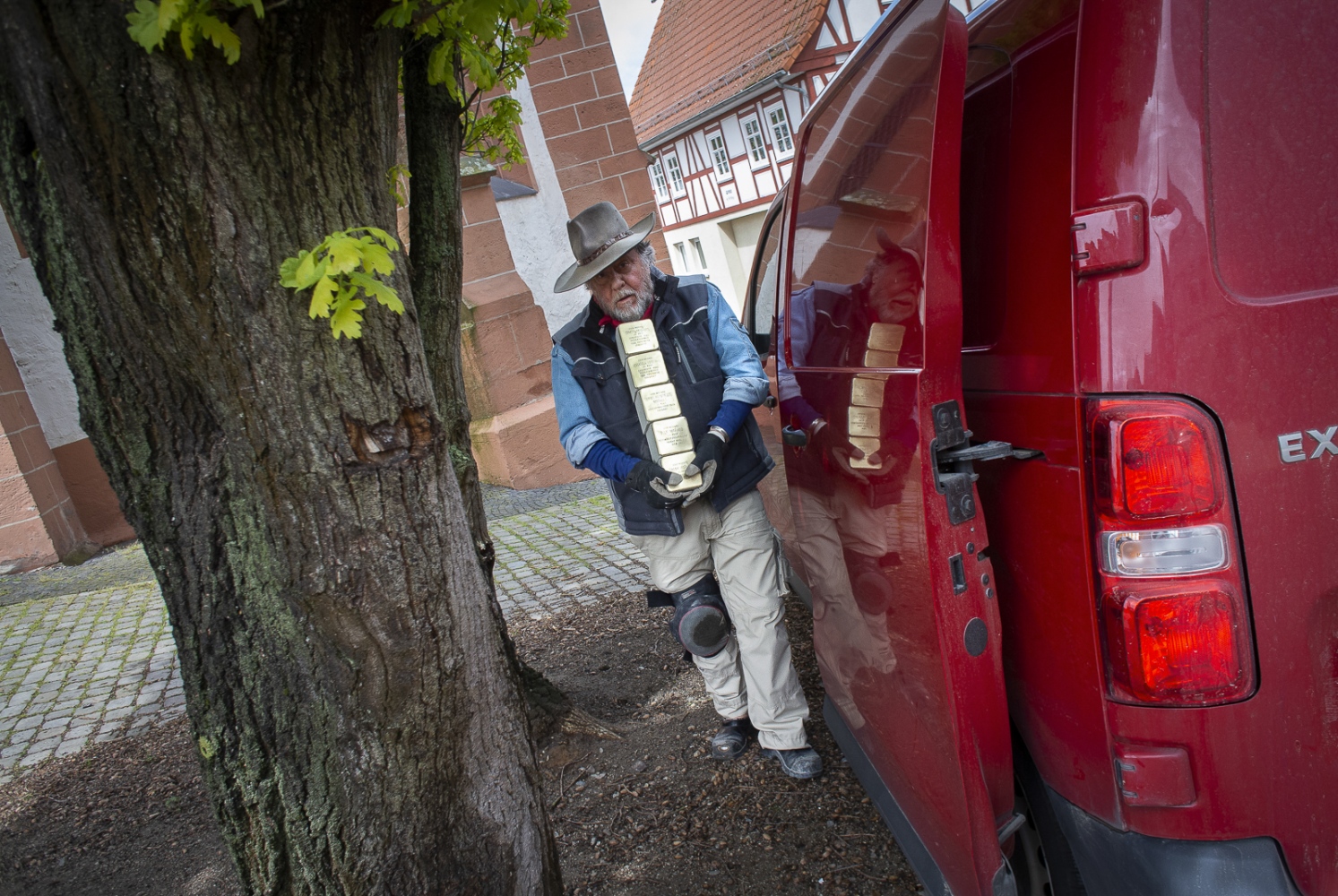Public Story
The making of a Stolperstein
The Making of a Stolperstein
Self taught sculptor Michael Friedrichs-Friedlaender stands in front of a small brass plaque in his workshop come garage in the Pankow district of Berlin and laments “The hard part is not the work itself. It is what happened to the people named. Here I am working on the names of 2 sisters aged 20 and 22. They were German and escaped Nazi Germany by fleeing to Belgium. But Belgium was overrun in the war and they were both captured and deported to Auschwitz. Murdered on their day of arrival. I still sometimes stop and cry while working here.” He and his assistant Asigora have just finished pouring a concrete mix into moulds which will be allowed to set overnight forming the base of a Stolperstein. Michael with hammer and chisel in hand now starts the engraving process.
A Stolperstein (literally translated “stumbling stone”) is a 10cm cubed concrete block with a brass plate covering one side. All are made by hand with an average of around 450 per month being produced from Friedlaender‘s studio. The brass plaque, moulded to one side of the squared concrete, records the name, date of birth and date of death, if known, of an individual who was a victim of the National Socialist government of Germany of the 1930‘s and 40‘s. The handcrafted memorial stone is then placed by the German Conceptual Artist Gunter Demnig, the originator of the “Stolpersteine” project, in the street paving outside of the last place of residency or work, freely chosen by an individual before they fell foul of the Nazi‘s. A Stolperstein is intended to be discovered or be noticed by chance only recognisable on close inspection. You literally stumble across it.
Widely perceived as a project linked to the Jewish Holocaust, it‘s creator Demnig states that his intention was “an art project that commemorates all the victims of National Socialism. Keeping alive the memory of all Jews, Roma, Sinti, Homosexuals, Dissidents, Jehovah Witnesses and victims of euthanasia who were deported and exterminated under the Nazi‘s”. It is the world‘s largest decentralised art project, a memorial reminder to the terror of the Nazi regime. Requests for having a Stolperstein laid come from within the communities, usually following a history research project from schoolchildren or local initiatives. This year it is expected to reach the number of 75,000 Stolpersteine having already been placed in 26 different countries and inscribed in 21 different languages.
Friedlaender has been making Stolpersteine for the last 14 years: “The first several thousand stones were made by Gunter himself and the very first was placed illegally in Thieboldsgasse 88 in Cologne. At the beginning they were even numbered! But it just became too much for him. Originally, he approached me and asked ‘Do you want to make the ones I cannot make?’ After 3 weeks I was making all of them.”
Over 400 kilometres away from the Stolpersteine workshop of Berlin, seventy-one -year-old Gunter Demnig sits in his converted farmhouse near Alsfeld in Hessen and is quoting from the Talmud, the central text of Rabbinic Judaism and the primary source of Jewish religious law: “A person is only forgotten when their name is forgotten.” He‘s preparing himself to set out for another day installing Stolpersteine at three separate venues near his home in Hesse. It‘s a labour of artistic love and commitment that last year took him on a journey of over 60,000 kilometres throughout Europe.
Demnig mentally anchors himself within the fabled “Generation 68”, the first generation in Germany that started asking their parents what really had happened under the Nazi‘s, and more crucially, why it was allowed to happen. While travelling to the first site that morning for the laying of the Stolperstein in Alheim, Demnig recalls the history of the Gas chamber in the National Socialism of the 30‘s: “The first gas chambers were at the hospitals for the handicapped and mentally ill in Germany. They were the beginning.” Outlining the role his art project plays in bringing the memories of what happened in Europe at this tragic time back to a more manageable human understanding, Demnig continues: “6 million is such a huge and abstract number. The Stolpersteine brings it home. Their placing reminds you that it all began here, in this street, in your street. It was your neighbour that was taken away to the gas chambers”.
Demnig grew up in Nauen, then the old GDR, and later when he was 8 years old he moved with his family to the Western part of Berlin. In 1967 he graduated from high school and began studying art education at the College of Fine Arts in Berlin, followed by a year of industrial design studies at the same university. From 1971onwards he continued his schooling in art education at the Kunsthochschule Kassel, passing his first state examination there in 1974. He started the “Stolpersteine” art project in 1992 with the first several hundred stones being numbered as Demnig originally thought it would be a one off art project. “I never had an idea that it would become such a big project”, he recalls.
Now in his 70‘s, Demnig has moved the “Stolpersteine” project on to an organised Foundation footing. A database is in the process of beingset up by his wife Katja, recording all names, dates and relative information for the stones so far placed: “Regarding my age we decided to establish a foundation, so the project can continue and has a life of its own after I retire”, Demnig confirms.
Returning home after a day of work laying stones in neighbouring Treysa, Ahlheim and Freisberg. Demnig takes a seat in the artist’s studio attached to his house: “’Stolpersteine is a work of life. It is so important that it is not forgotten what has happened, so that it will never happen again. Ein Mensch, ein Name, ein Stein.”
© Craig Stennett





























